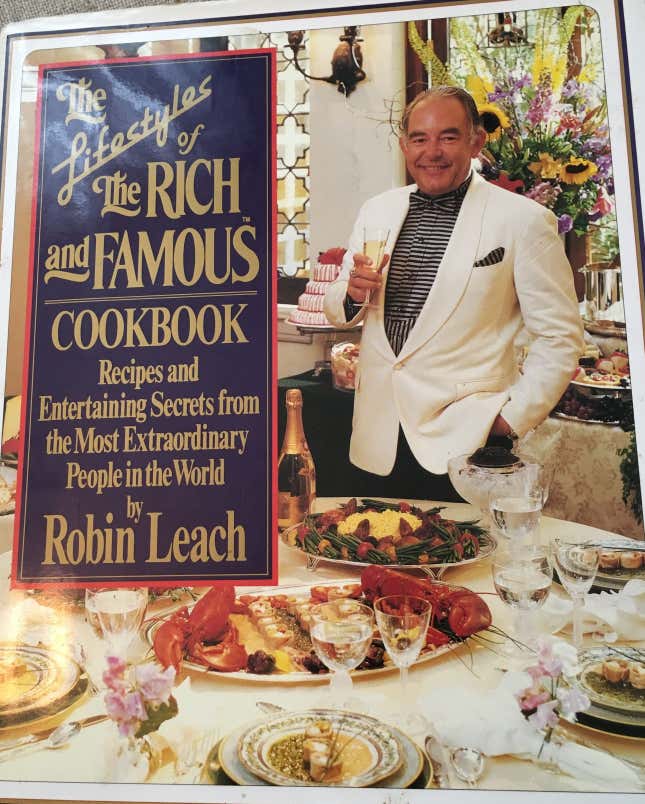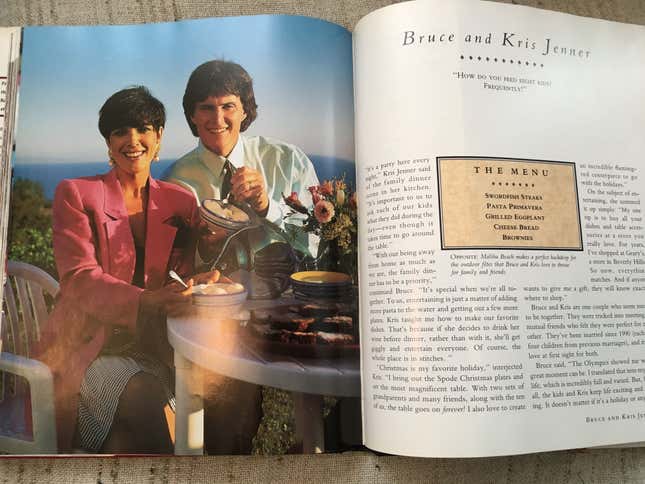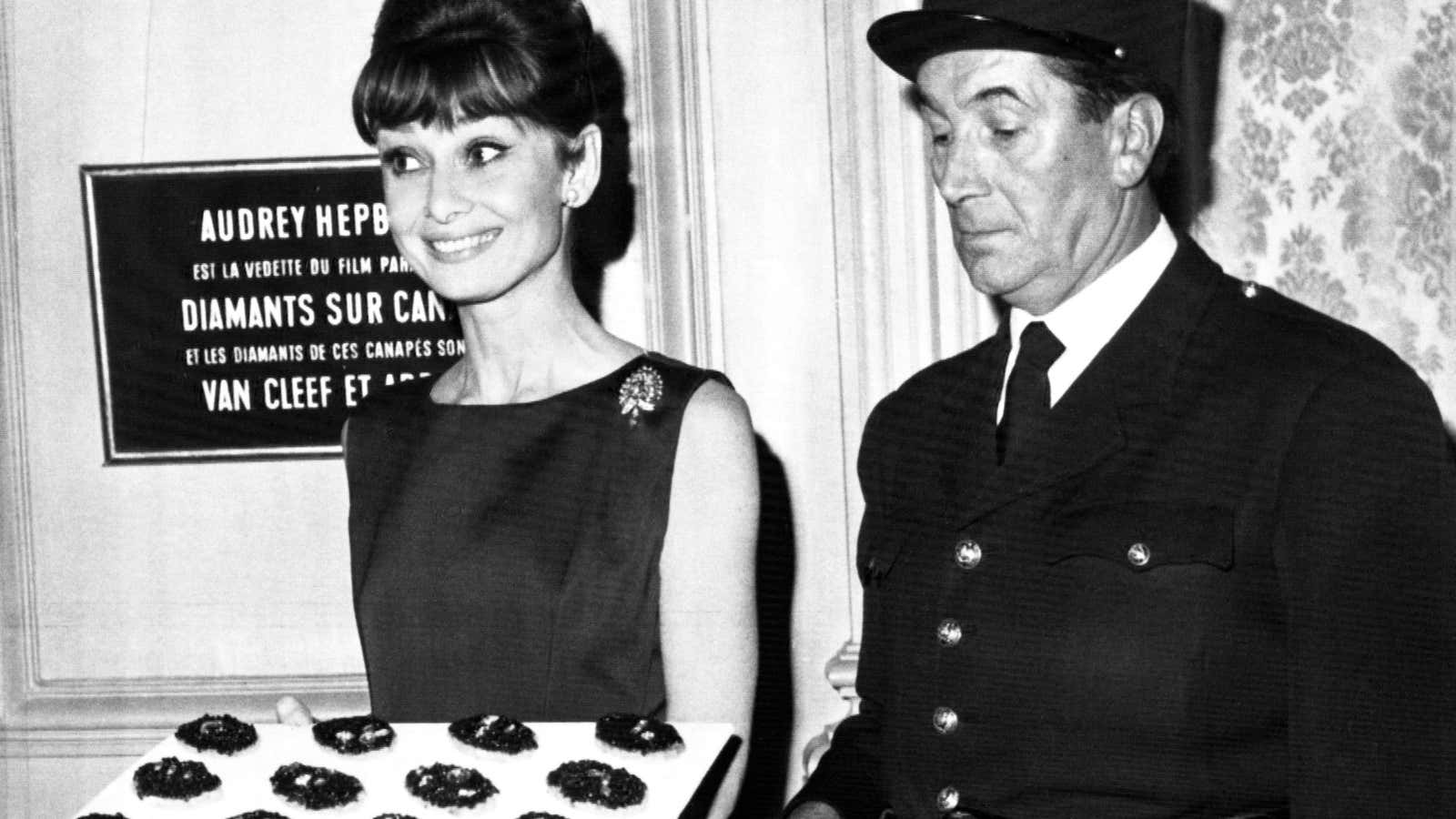The cover of The Lifestyles of the Rich and Famous Cookbook—Recipes and Entertaining Secrets from the Most Extraordinary People in the World, is like a hidden pictures game from Highlights magazine imploring you to circle the signifiers of wealth. Lobsters flank a platter of canapés. A silver bowl mounded with caviar rests on a bed of ice. In the foreground a plate appears to be sauced with a gold leaf purée. White chocolate-dipped strawberries and a classic Charlotte Royale peek out from behind a dinner jacketed Robin Leach, holding a glass of Champagne. Crystal glasses and heavy silver abound, daring you to guess which to use first.

I have a slight obsession with thrift store cookbooks. Yes, I’ve scored classics like Laurel’s Kitchen for pennies, but what I really love are books that speak of a time and a place in their very obsolescence—you’ll never cook an actual meal from these books, and perhaps you were never intended to in the first place. What The Lifestyles of the Rich and Famous Cookbook does instead is preserve in amber what fancy food meant in 1991, and, on a larger scale, what the idea of wealth and fame signified a generation ago.
The people who are profiled in this book can be divided up into a few rough categories, namely old Hollywood, royalty, business luminaries, and celebrities. The menu for Elizabeth Taylor’s 1991 wedding at Michael Jackson’s Neverland Ranch is included, as well as the menu from Ernest and Tova Borgnine’s vow renewal ceremony on a yacht. Joan Collins, of Dynasty fame, shares her recipe for spaghetti bolognese, which she serves on plates accented in 24-karat gold. Ivana Trump shows off her own gold table settings at a “girlfriends lunch” in her Connecticut mansion, at which she serves Moroccan salmon and foie gras stuffed pastry.
In the recently released documentary Generation Wealth filmmaker Lauren Greenfield looks back over the past 25 year she has spent documenting the lifestyles of the very wealthy, a time period that begins just after The Lifestyles of the Rich and Famous Cookbook was published. The film is part of a larger photography exhibit and retrospective which Greenfield describes as, “looking at how the American dream has been kind of taken over by the values of consumerism. It’s about our aspiration to wealth.”
In 1991, at least in the pages of Leach’s cookbook, wealth seemed far removed from the average person—you read because you wanted a peek into the castle, to glimpse the details of a gala, a celebrity wedding, or how stars behaved at home. A generation later we’re used to seeing celebrities in workout gear, slurping iced lattes with no makeup on, and not just imagining ourselves buying, and eating, the same things, but making the same consumer choices, and even buying their brands. How did we go from Folgers Crystals versus hand-pulled espresso, to Starbucks for all?
Rich people used to eat rich food
The food in The Lifestyles of the Rich and Famous Cookbook largely follows the lead from the cover. Lobster, caviar, truffles, veal dishes, and rich chocolate desserts dominate the pages. Even their homey, celebrities-they’re-just-like-us dishes—Ivana Trump and Eva Gabor both share favorite goulash recipes, Randy Travis contributes his favorite fried chicken and buttermilk pie—are all serious rib stickers. No one is talking about heirloom tomatoes or organic anything. In 1991, stars like Gabor and pasta-pusher Joan Collins may have been rich, but they experienced the privation of World War II-era Europe as children, Gabor in Hungary, Collins in England. Special food wasn’t just about exotic ingredients, it was about calories, and plenty of them.
Celebrity food culture now is inextricably linked with wellness—which actually means thinness. From the idea of “clean eating” to the various juices, tonics, and supplements promising to boost everything from your brain power to your sex life featured on Gwyneth Paltrow’s wellness hive, Goop, fancy food is much more austere now. Rather than pointing to a simpler past, it promises an unlined future, in which the glow of youth remains incandescent, powered by dried mushroom powder and matcha smoothies.
Rich means something different now
The wealth that Robin Leach chronicled on his television show from 1984 to 1995, has a warm, fuzzy glow to it. Prior to reality television, a shoot in someone’s home was a highly choreographed and set dressed affair. Writing about how the luxury market has changed over the past generation, my Quartzy colleague Marc Bain described old school wealth as “a walled garden.” In this space there were no photo bombs, no selfies, and no gotcha moments. Wealth is always presented with a sort of reverence and gravitas, which is also very much on display in the cookbook. In one section a Bolivian tin heiress invites readers into her private compound in Mexico for a “nouvelle Mexican” menu that includes chicken tacos and “Mexican apple pie.” How very 20th century.
This era ended with the introduction of two shows—MTV Cribs in 2000 and Who Wants to Marry a Millionaire in 2002. Cribs shed any illusion that wealth and taste go together. Its arguably most famous episode involves Mariah Carey’s pets fighting, and the singer compulsively changing outfits throughout the hour-long special. Millionaire challenged the quantitative concept of what being wealthy means. Its original star, Rick Rockwell, was deemed not rich enough when his home proved to be more split-level and less castle, despite claiming net assets of $2 million.
Wealth now is more over the top even, than gilded lobster served on the veranda of a palace. It’s not about obvious, indulgent pleasures, so much as rarified tastes. It’s belonging to a food tribe (paywall). It’s Soylent. It’s flying to a remote Scottish island to eat fermented lamb and local lichens at a restaurant rated one of the best, and more expensive, in the world.

Famous for being famous
The people featured in The Lifestyles of the Rich and Famous Cookbook are generally famous for either being born rich or having worked to become rich. They’re royalty or society types, or actors, real estate magnates, caviar brokers, professional athletes. There are a few standouts in the book though, whose fame and fortune are still culturally important.
Martha Stewart and, as they were then known, Bruce and Kris Jenner, offer the most modern dishes in the book by far. Stewart serves a menu with bibb lettuce salad, brie on grilled bread, and sesame chicken in an acorn squash. An apple pie, too, of course. The Jenners feed their eight children grilled swordfish, eggplant, pasta primavera, and brownies for dessert. Vegetable-forward, fresh, flavorful—you could easily envision either of these menus in the August 2018 issue of your favorite food magazine, or at a local bistro.
Stewart built an empire on making her enviable lifestyle accessible to the masses, from her Kmart sheet sets and paint colors, to her meticulous recipes. The Jenners, who at some point in the mid-2000s became the Kardashians, set the standard for being famous for being famous. They took all the lessons from Cribs and Who Wants to Marry a Millionaire and then wrote their own masterclass in being culturally omnipresent without seeming to actually do much of anything.
The lifestyle maven and the fame seekers, these two outliers still have influence in a way that say, Dame Barbara Cartland and her mini pastry shells with shrimp, just doesn’t. While combing through photos from the 90s for Generation Wealth, Greenfield found several shots of Kim Kardashian as a young teenager that she didn’t even realize she had, because the reality star did not yet stand out among her equally privileged peers.
There’s an outlook embedded in our menus, just as there is in how we come by our wealth. You see the early trappings of a new vision of wealth in what young Kim was eating at family dinner, at least according to Leach’s cookbook. Brownies! They might be fabulously wealthy, but the Jenner-Kardashians are just like us. You might not realistically aspire to a castle—or even a living wage—but a pan full of chocolatey squares, and an Instagram account? Those let us see inside the walled garden, just a bit.
